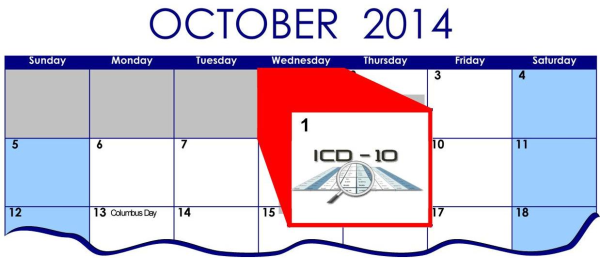The United States Department of Justice (“DOJ”) and the State of Michigan filed suit on October 18, 2010 against Blue Cross Blue Shield of Michigan (BCBSM). The DOJ alleges that BCBSM’s use of “Most Favored Nation” clauses in its contracts with hospitals and providers inMichiganis anticompetitive. These preferential pricing policies, known in the hospital and insurance industries as “most favored nation” clauses typically require that BCBSM receive the lowest rates the participating providers and/or hospitals offer. Participating providers and/or hospitals are then required to charge any competing plan an agreed percentage above the rate provided to BCBSM.
Medical Billing Blog
Blues Ordered To Stop "Most Favored Nation" Contracts
The federal government has finalized a one-year delay for the nationwide conversion to ICD-10 code sets beginning Oct. 1, 2014. HHS Secretary Kathleen Sebelius has announced a final rule establishing a one-year delay - from Oct. 1, 2013, to Oct. 1, 2014 in the use of the ICD-10 Coding system.
Meaningful Use Stage 2 Requirement Changes
On Thursday, August 23, 2012, U.S. Department of Health and Human Services Secretary Kathleen Sebelius announced that the Centers for Medicare & Medicaid Services (CMS) published the final rule for Stage 2 Meaningful Use for the Electronic Health Record (EHR) Incentive Programs. The rule provides new criteria that eligible professionals (EPs), eligible hospitals, and critical access hospitals (CAHs) must meet in order to successfully participate in the EHR Incentive Programs.
For most practices, the process of adopting and implementing an Electronic Health Record System is daunting enough. It can take as long as a year to fully integrate the EHR into the daily procedures of the practice, and most practices find themselves on a whirlwind roller coaster ride when it comes to devising and fine-tuning new routines to make using the EHR as effectively as possible. In the long run, switching to electronic records is worth it in terms of time saved, errors reduced, and being able to offer the additional soft services available from those who use an electronic record system.
Billing and Coding For the Medicare Annual Wellness Visits
By Christine Moore, CPC -- There seems to be some confusion out there from both physician offices and patients as to what is included in the Medicare Wellness Visits. Office staff should be familiar with codes G0402, G0438, and G0439 to be able to explain to patients the purpose and scope of these visits. Medicare coverage includes three different types of Wellness Visits that are offered to all enrollees, but these visits do not include a routine physical checkup. They are intended to be a meeting between physician and patient to discuss current health status, and to devise a plan for maintaining good health, setting a schedule for preventive health screenings, and treating or stabilizing chronic ailments. Medicare beneficiaries are eligible to receive the services associated with the Wellness Visits at no charge to the patient, with no copay or deductible due for the Annual Wellness Visit (AWV) itself, but if other services are provided during the course of the AWV, the patient is responsible for any copay or deductible applicable to those extra services. Together, the three types of wellness visits are designed to establish and maintain regular contact between patient and physician, to ease communication about health and wellness issues, and to provide a basis for regular updating of patient records with regard to overall health. Each type of visit is indicated at a specific point during the term of the patient’s coverage under Medicare, and there are specific guidelines for time periods during which each visit is payable.
Where Should I Send My Bill? Treating Young Adults (Part 3 of 3)
Ralph Sitler III, J.D. -- In the first two installments of this blog series, we covered some fundamental principles that deal with providing care to minors, obtaining appropriate authorization to provide the care, and how to determine who is responsible to pay for the services rendered. As discussed, it’s not always the parent or guardian of the minor obtaining services.
CMS Starts Meaningful Use Audits for EMR Adopters
Under the 2009 federal economic stimulus package, health care providers who demonstrate meaningful use of a certified electronic health record system qualify for Medicare or Medicaid incentive programs.
Who Pays For Services Provided To Minors? (Part 2 of 3)
By Ralph Sitler III, JD -- Last week, we discussed why it’s important for providers to consider the type of service rendered to minors when determining who has authority to contract that service, and how to determine who bears financial responsibility to pay for those services under various conditions. Essentially, we covered what types of services minors can authorize on their own behalf, and whom to bill for the services. We also discussed some pretty serious considerations to take into account when submitting claims to an insurance plan for reimbursement of services self-authorized by minors when the insurance plan policy holder is the minor’s parent or guardian. HIPAA guidelines are a little vague when it comes to notification of other individuals when a minor has self-authorized, so be sure to check out that first blog in this series to make sure you’re up to date on the guidelines.
What You Need To Know About Payment For Service To Minors
By Ralph Sitler III, JD -- It’s important for health care providers to determine how the services rendered will be paid, and who is responsible for payment. Since financial responsibility often falls on a guarantor other than the patient, it can be a can of worms to try to figure out where to send the bill for certain patients under certain circumstances. For example, it can be difficult to assess financial responsibility when treating minors. This is because minors can fall into any of several demographic categories when treatment is sought, and can even authorize their own care in some instances. Because of this situational power to authorize their own care, the parents or guardians of a minor may at times disclaim financial responsibility for services rendered to the child. So if a bill goes unpaid, can you pursue the parent or guardian for payment? Maybe, maybe not.
Practice Management Considerations During EMR Chart Conversion
With the advent of Electronic Medical Records implementation industry wide, it is likely that you too have taken the plunge and purchased an electronic solution for your practice’s patient management. But once you’ve purchased your Electronic Medical Record (EMR) you will also have to decide what to do with your existing patient files, and figure out the best way to use them in conjunction with your new EMR. When beginning any medical chart conversion effort, it is important to make sure the information you’re loading into your EMR will be of the most value to you on a day to day basis. It’s a good idea to determine which patients are active, and which are no longer likely to seek care from your practice. In most cases, patients who have not been in to seek care for a period of 18 to 24 months would be classified as inactive. In the case of these patients, it doesn’t make sense to spend a lot of time and energy importing their charts to the EMR, so records for these patients can be moved to your archives, and retrieved in the event they do happen to return for care. You can then convert the chart prior to their visit, and have the information in the electronic format when they come back.





















